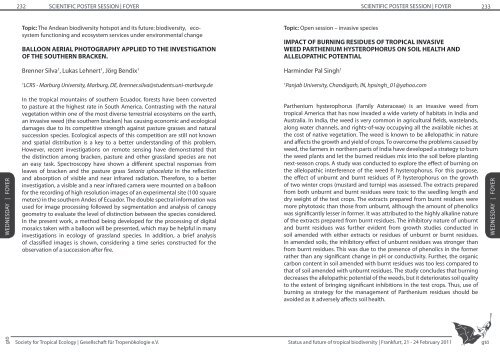Abstract booklet - gtö – Society for Tropical Ecology
Abstract booklet - gtö – Society for Tropical Ecology
Abstract booklet - gtö – Society for Tropical Ecology
Create successful ePaper yourself
Turn your PDF publications into a flip-book with our unique Google optimized e-Paper software.
232 SCIENTIFIC POSTER SESSION | FOYERSCIENTIFIC POSTER SESSION | FOYER233Topic: The Andean biodiversity hotspot and its future: biodiversity, ecosystemfunctioning and ecosystem services under environmental changeBALLOON AERIAL PHOTOGRAPHY APPLIED TO THE INVESTIGATIONOF THE SOUTHERN BRACKEN.Topic: Open session – invasive speciesIMPACT OF BURNING RESIDUES OF TROPICAL INVASIVEWEED PARTHENIUM HYSTEROPHORUS ON SOIL HEALTH ANDALLELOPATHIC POTENTIALBrenner Silva 1 , Lukas Lehnert 1 , Jörg Bendix 1Harminder Pal Singh 11LCRS - Marburg University, Marburg, DE, brenner.silva@students.uni-marburg.de1Panjab University, Chandigarh, IN, hpsingh_01@yahoo.comWEDNESDAY | FOYERIn the tropical mountains of southern Ecuador, <strong>for</strong>ests have been convertedto pasture at the highest rate in South America. Contrasting with the naturalvegetation within one of the most diverse terrestrial ecosystems on the earth,an invasive weed (the southern bracken) has causing economic and ecologicaldamages due to its competitive strength against pasture grasses and naturalsuccession species. Ecological aspects of this competition are still not knownand spatial distribution is a key to a better understanding of this problem.However, recent investigations on remote sensing have demonstrated thatthe distinction among bracken, pasture and other grassland species are notan easy task. Spectroscopy have shown a different spectral responses fromleaves of bracken and the pasture grass Setaria sphacelata in the reflectionand absorption of visible and near infrared radiation. There<strong>for</strong>e, to a betterinvestigation, a visible and a near infrared camera were mounted on a balloon<strong>for</strong> the recording of high resolution images of an experimental site (100 squaremeters) in the southern Andes of Ecuador. The double spectral in<strong>for</strong>mation wasused <strong>for</strong> image processing followed by segmentation and analysis of canopygeometry to evaluate the level of distinction between the species considered.In the present work, a method being developed <strong>for</strong> the processing of digitalmosaics taken with a balloon will be presented, which may be helpful in manyinvestigations in ecology of grassland species. In addition, a brief analysisof classified images is shown, considering a time series constructed <strong>for</strong> theobservation of a succession after fire.Parthenium hysterophorus (Family Asteraceae) is an invasive weed fromtropical America that has now invaded a wide variety of habitats in India andAustralia. In India, the weed is very common in agricultural fields, wastelands,along water channels, and rights-of-way occupying all the available niches atthe cost of native vegetation. The weed is known to be allelopathic in natureand affects the growth and yield of crops. To overcome the problems caused byweed, the farmers in northern parts of India have developed a strategy to burnthe weed plants and let the burned residues mix into the soil be<strong>for</strong>e plantingnext-season crops. A study was conducted to explore the effect of burning onthe allelopathic interference of the weed P. hysterophorus. For this purpose,the effect of unburnt and burnt residues of P. hysterophorus on the growthof two winter crops (mustard and turnip) was assessed. The extracts preparedfrom both unburnt and burnt residues were toxic to the seedling length anddry weight of the test crops. The extracts prepared from burnt residues weremore phytotoxic than those from unburnt, although the amount of phenolicswas significantly lesser in <strong>for</strong>mer. It was attributed to the highly alkaline natureof the extracts prepared from burnt residues. The inhibitory nature of unburntand burnt residues was further evident from growth studies conducted insoil amended with either extracts or residues of unburnt or burnt residues.In amended soils, the inhibitory effect of unburnt residues was stronger thanfrom burnt residues. This was due to the presence of phenolics in the <strong>for</strong>merrather than any significant change in pH or conductivity. Further, the organiccarbon content in soil amended with burnt residues was too less compared tothat of soil amended with unburnt residues. The study concludes that burningdecreases the allelopathic potential of the weeds, but it deteriorates soil qualityto the extent of bringing significant inhibitions in the test crops. Thus, use ofburning as strategy <strong>for</strong> the management of Parthenium residues should beavoided as it adversely affects soil health.Wednesday WEDNESDAY 16:00 | FOYER | Foyergtö<strong>Society</strong> <strong>for</strong> <strong>Tropical</strong> <strong>Ecology</strong> | Gesellschaft für Tropenökologie e.V. Status and future of tropical biodiversity | Frankfurt, 21 - 24 February 2011gtö












